Overview of the French number system
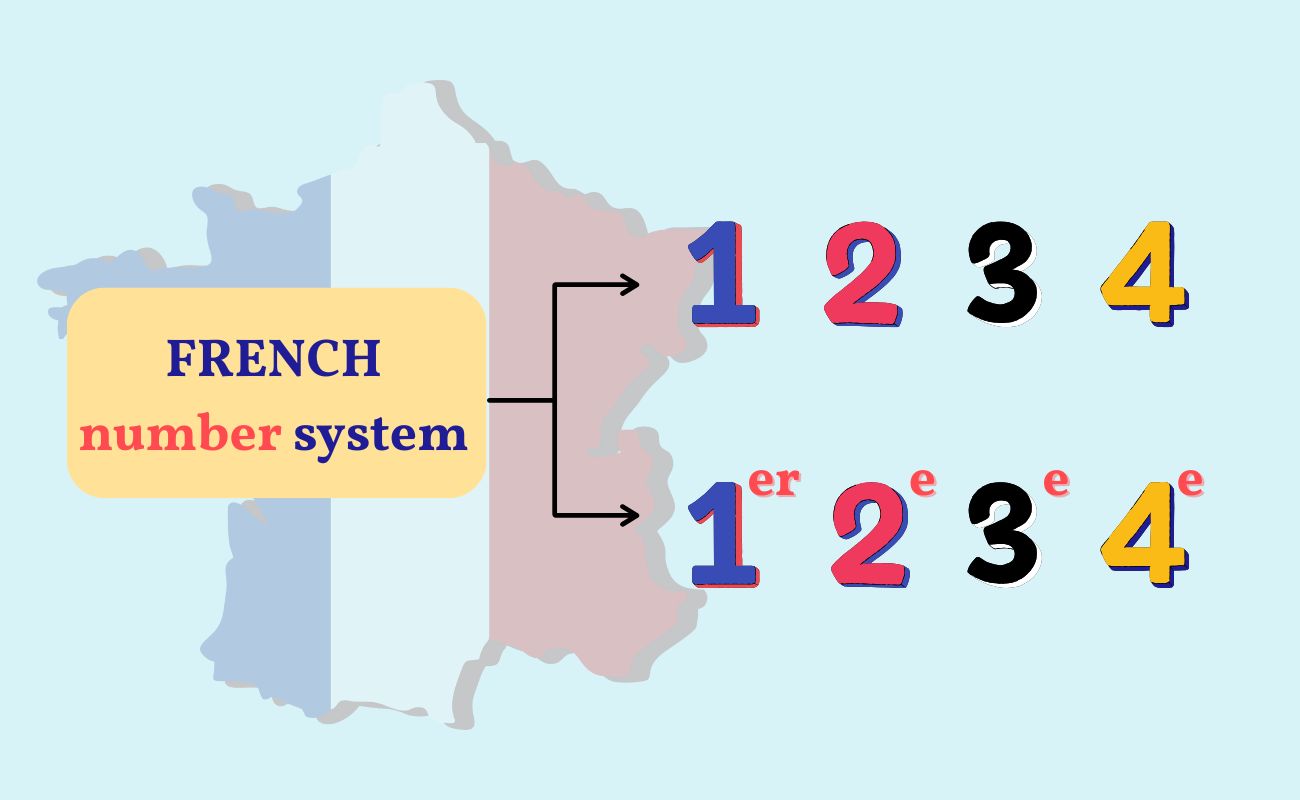
In French, numbers fall into two main types: cardinal and ordinal. In particular:
- Cardinal numbers (un, deux, trois…): show quantity. They tell you “how many”, they count.
- Ordinal numbers (premier, deuxième, troisième…): show position. They tell you “which one”, they rank.
While cardinals stay neutral, ordinals agree in gender and number, just like adjectives.
You’ll also notice variants that depend on gender, context, and even pronunciation. For example, premier becomes première when describing a feminine noun, and vingt sometimes takes an s (as in quatre-vingts), a detail that’s small in writing but big in meaning.
Number in French from 0 to 100
French numbers have a clear logic once you spot the patterns. From zéro to soixante-neuf, every block builds on what came before. Let’s break them down step by step so you can hear the logic behind the count.
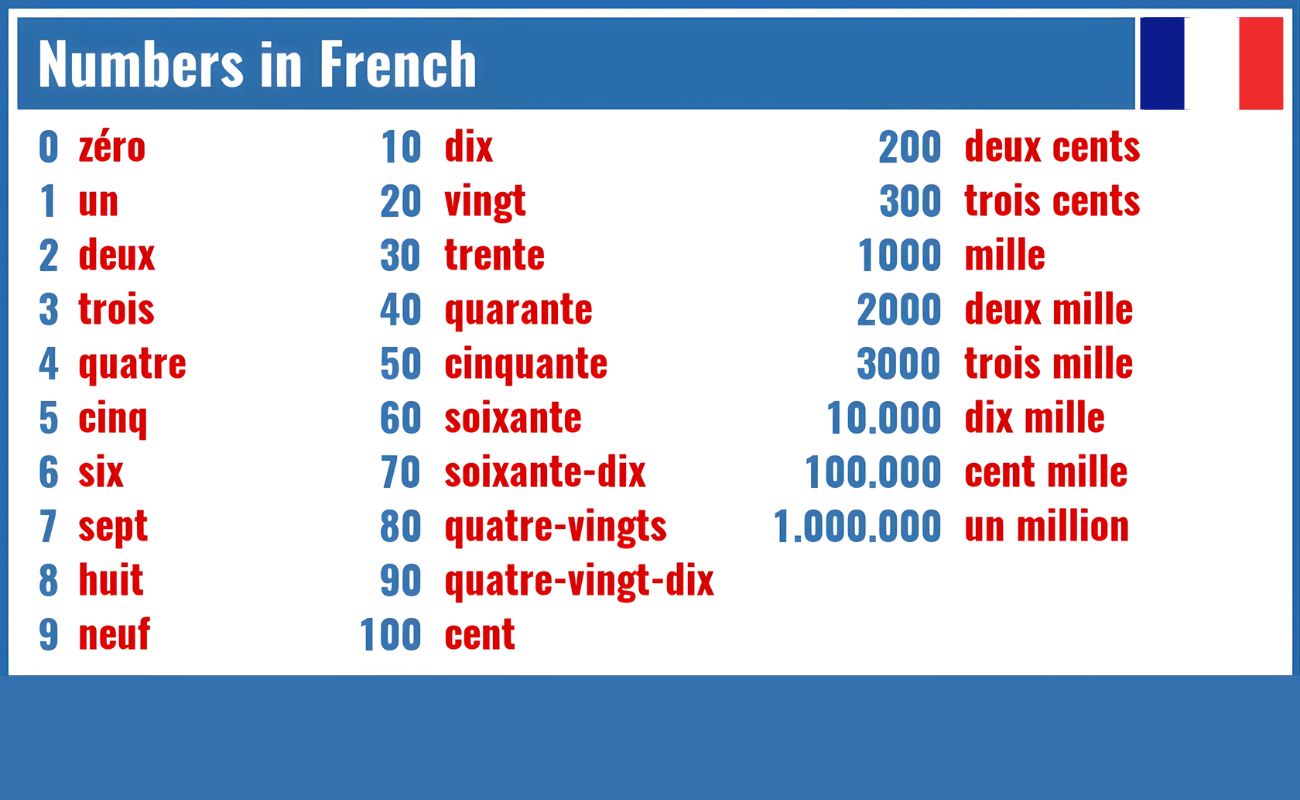
French numbers 0 – 20
This is the foundation of all counting in French. Each number has a unique word form; there’s no formula yet, so these are the ones you’ll simply need to remember.
| Number | French | Pronunciation (IPA) |
| 0 | zéro | /ze.ʁo/ |
| 1 | un | /œ̃/ |
| 2 | deux | /dø/ |
| 3 | trois | /tʁwa/ |
| 4 | quatre | /katʁ/ |
| 5 | cinq | /sɛ̃k/ |
| 6 | six | /sis/ |
| 7 | sept | /sɛt/ |
| 8 | huit | /ɥit/ |
| 9 | neuf | /nœf/ |
| 10 | dix | /dis/ |
| 11 | onze | /ɔ̃z/ |
| 12 | douze | /duz/ |
| 13 | treize | /tʁɛz/ |
| 14 | quatorze | /ka.tɔʁz/ |
| 15 | quinze | /kɛ̃z/ |
| 16 | seize | /sɛz/ |
| 17 | dix-sept | /dis.sɛt/ |
| 18 | dix-huit | /diz.ɥit/ |
| 19 | dix-neuf | /diz.nœf/ |
| 20 | vingt | /vɛ̃/ |
From 17 to 19, the logic begins: dix (ten) combines with the next number (sept, huit, neuf). This same idea of combining blocks drives the rest of French counting.
French numbers 21 – 69
Now, the beauty of the French numbering system appears: additive formation. Numbers in this range are formed by combining the “tens” with the “units.”
The tens in French
| Tens | French | Pronunciation |
| 20 | vingt | /vɛ̃/ |
| 30 | trente | /tʁɑ̃t/ |
| 40 | quarante | /ka.ʁɑ̃t/ |
| 50 | cinquante | /sɛ̃.kɑ̃t/ |
| 60 | soixante | /swa.sɑ̃t/ |
Formula: tens + (et) + unit
- The conjunction et (“and”) appears only before “un”:
vingt et un (21), trente et un (31), quarante et un (41) - For all other numbers, use a hyphen:
vingt-deux, trente-trois, quarante-cinq
For example:
- 21: vingt et un (twenty and one)
- 22: vingt-deux (twenty-two)
- 35: trente-cinq (thirty-five)
- 48: quarante-huit (forty-eight)
- 59: cinquante-neuf (fifty-nine)
- 60: soixante (sixty)
French numbers 70 – 99
At seventy, French numbers start to look unusual, but the logic stays intact. Instead of inventing new words for seventy, eighty, and ninety, the French use smaller blocks you already know.
- From 70 to 79
In the seventies, French adds numbers ten to nineteen to soixante (60):
| Number | French | Literal meaning |
| 70 | soixante-dix | sixty-ten |
| 71 | soixante et onze | sixty and eleven |
| 72 | soixante-douze | sixty-twelve |
| 73 | soixante-treize | sixty-thirteen |
| 74 | soixante-quatorze | sixty-fourteen |
| 75 | soixante-quinze | sixty-fifteen |
| 76 | soixante-seize | sixty-sixteen |
| 77 | soixante-dix-sept | sixty-seventeen |
| 78 | soixante-dix-huit | sixty-eighteen |
| 79 | soixante-dix-neuf | sixty-nineteen |
- From 80 to 99
The logic continues. French uses quatre-vingts, literally “four twenties”, for 80. This pattern, known as vigesimal counting (base 20), dates back to early Celtic influence on the French language.
| Number | French | Literal meaning |
| 80 | quatre-vingts | four twenties |
| 81 | quatre-vingt-un | four twenty-one |
| 82 | quatre-vingt-deux | four twenty-two |
| 90 | quatre-vingt-dix | four twenty-ten |
| 91 | quatre-vingt-onze | four twenty-eleven |
| 99 | quatre-vingt-dix-neuf | four twenty-nineteen |
A few small spelling details matter here:
- Quatre-vingts (80) ends with an -s, but the -s disappears when another number follows: quatre-vingt-un, quatre-vingt-deux.
- There is no et before un after 80.
French numbers over 100
After ninety-nine, French returns to simplicity. The pattern you’ve learned continues, but with new building blocks: cent (hundred), mille (thousand), and million (million).
Formula for hundreds: unit + cent(s) (+ number)
| Number | French |
| 100 | cent |
| 200 | deux cents |
| 300 | trois cents |
| 400 | quatre cents |
| 500 | cinq cents |
Formula for thousands and beyond: number + mille / million / milliard
| Number | French |
| 1,000 | mille |
| 2,000 | deux mille |
| 10,000 | dix mille |
| 100,000 | cent mille |
| 1,000,000 | un million |
| 1,000,000,000 | un milliard |
Grammar rules stay simple:
- Mille never takes -s.
- Million and milliard are nouns and take -s in the plural, followed by de: deux millions d’habitants, trois milliards d’euros.
How to write a number in French correctly
Writing a number in French follows clear conventions, but they’re not exactly the same as in English. A few small details, like where to place hyphens or commas, can completely change how a number looks on paper.
Let’s go through the three key rules that keep written French numbers consistent and professional.
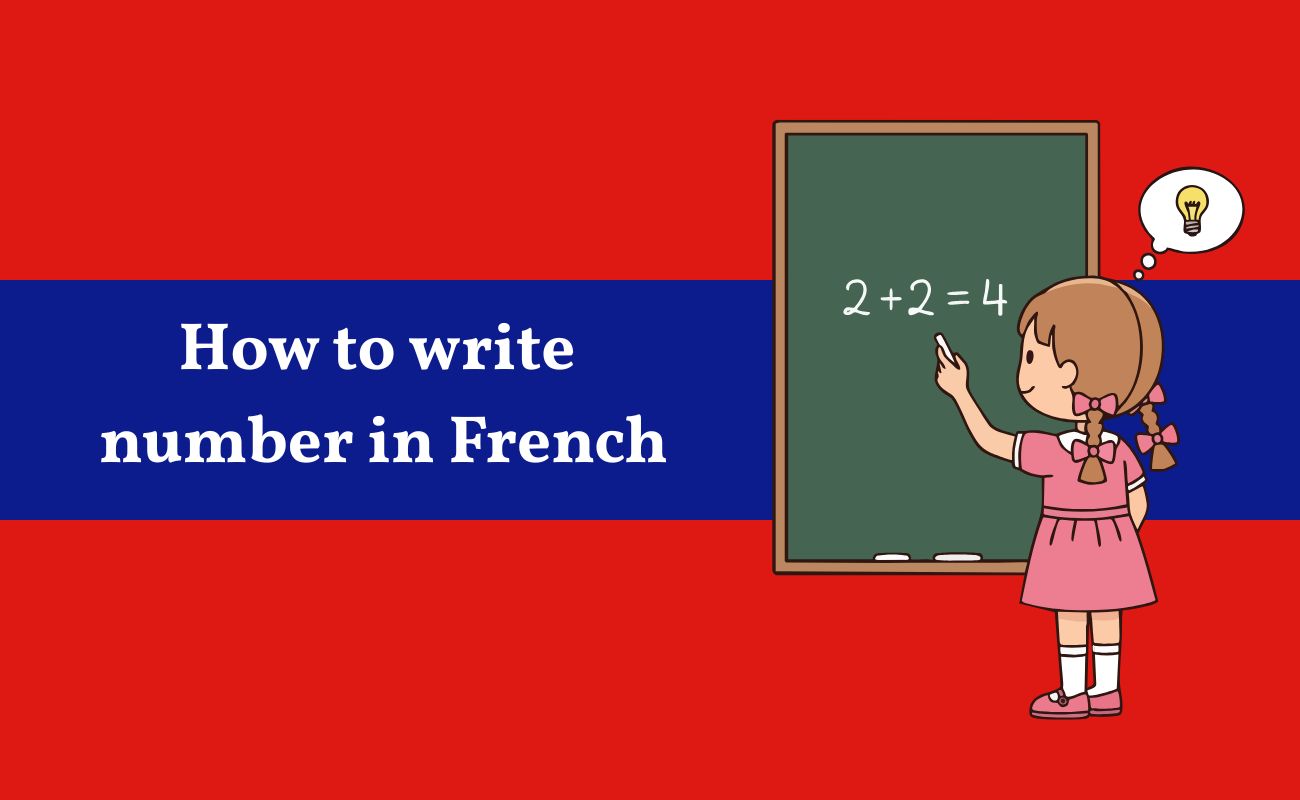
Hyphen in French numbers
Until 1990, hyphens were used inconsistently: some numbers had them, others didn’t. The modern spelling reform (rectifications orthographiques de 1990) made things simpler:
All elements of a compound number should now be connected with hyphens.
For example:
- 22: vingt-deux
- 61: soixante-et-un
- 99: quatre-vingt-dix-neuf
This rule applies to every number below one million. However, older forms without full hyphenation are still accepted in formal writing, so you may see both versions in books or older documents.
Commas and periods in numbers
This is one of the most common traps for English speakers. French and English use punctuation differently when writing figures.
In English, a comma separates thousands, and a period marks decimals: 5,000.25
In French, it’s the opposite: 5 000,25
Key points:
- A space is used to separate thousands: 300 000 000 (not 300,000,000).
- A comma is used for decimals: 2,5 euros = “2.5 euros.”
Uppercase vs lowercase in writing numbers
In French, numbers written in words are always in lowercase, unless they start a sentence.
Examples:
- quatre-vingt-dix-sept
- deux cents soixante mille
- Soixante-dix-neuf mille quatre cent vingt-huit (capitalized only because it begins the sentence)
This rule also applies in official and academic writing. Using lowercase keeps the visual flow of French text clean and consistent, one of the small touches that signals precision and fluency.
French ordinal numbers (1st, 2nd, 3rd…)
Ordinal numbers express order or rank: first, second, third, and so on. In French, they follow clear, logical rules derived directly from the cardinal numbers you’ve already learned.
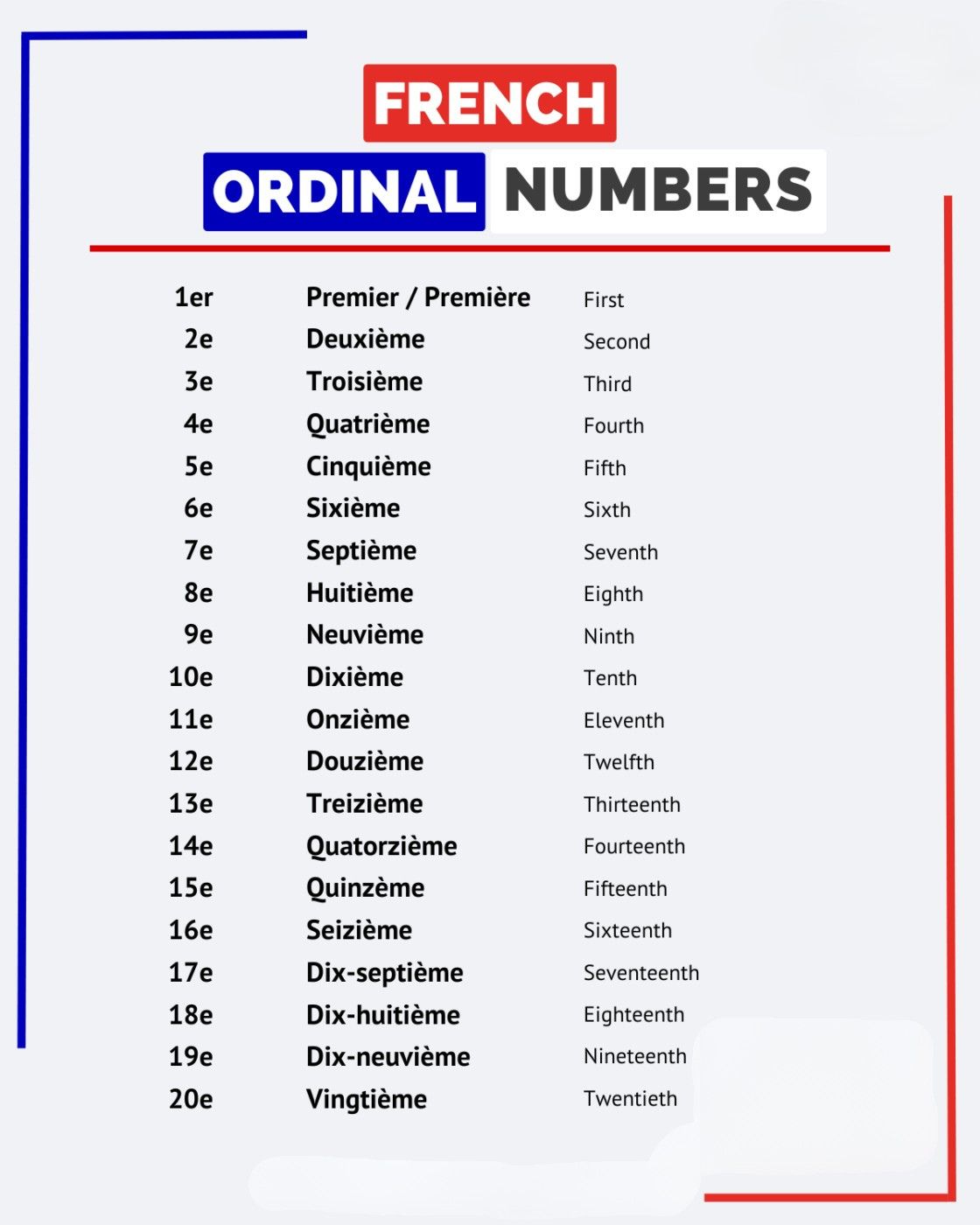
1. How ordinal numbers are formed
The general rule is:
Ordinal = cardinal number + –ième
Example:
- trois → troisième (third)
- quatre → quatrième (fourth)
- six → sixième (sixth)
However, there are a few simple spelling adjustments to keep in mind:
- If the number ends in –e, drop the e before adding –ième: quatre → quatrième
- For cinq, change q to qu → cinquième
- For neuf, change f to v → neuvième
The only true irregular form is premier/première (first). This one also changes for gender: premier for masculine nouns and première for feminine ones. All other ordinal numbers are gender-neutral.
2. French ordinal number chart
| Cardinal | Ordinal (masc. / fem.) | English equivalent | French abbreviation |
| un | premier / première | 1st | 1er / 1re |
| deux | deuxième | 2nd | 2e |
| trois | troisième | 3rd | 3e |
| quatre | quatrième | 4th | 4e |
| cinq | cinquième | 5th | 5e |
| six | sixième | 6th | 6e |
| sept | septième | 7th | 7e |
| huit | huitième | 8th | 8e |
| neuf | neuvième | 9th | 9e |
| dix | dixième | 10th | 10e |
| onze | onzième | 11th | 11e |
| vingt-trois | vingt-troisième | 23rd | 23e |
| cinquante | cinquantième | 50th | 50e |
| cent | centième | 100th | 100e |
5 quick exercises to master French numbers
Understanding the rules is one thing, but fluency comes from practice. These short exercises will help you reinforce what you’ve learned and start using numbers naturally in everyday situations.
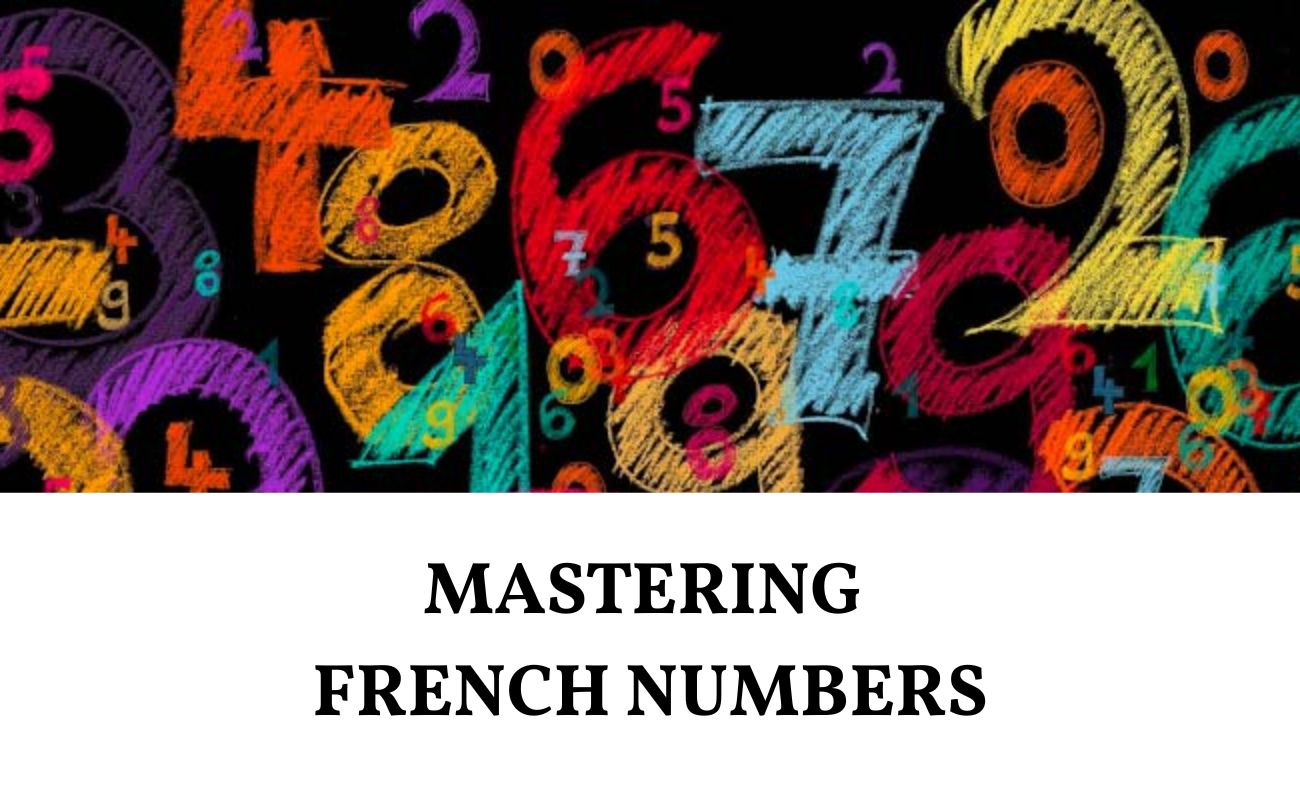
Exercise 1. Count aloud.
Start by counting from 0 to 100 out loud, first slowly, then faster. Try alternating directions: zéro à cent, then cent à zéro.
Exercise 2. Practice with real-world numbers.
Read everyday figures in French: phone numbers, prices, and years. For example:
- €47,50 → quarante-sept euros cinquante
- 06 82 14 33 09 → zéro six, quatre-vingt-deux, quatorze, trente-trois, zéro neuf
Exercise 3. Listen and repeat.
Use short audio clips or French learning apps. Play recordings of numbers and repeat them exactly as you hear them. Focus on stress and linking should sound like one fluid word. This mimics how native speakers blend sounds naturally.
Exercise 4. Apply numbers in real-life situations.
Incorporate numbers into daily speech: tell the time, give prices, describe quantities, or talk about dates. For instance:
- Il est huit heures trente. → It’s 8:30.
- J’ai trois chats et deux chiens. → I have three cats and two dogs.
Exercise 5. Quiz yourself with mixed questions
Create mini-quizzes for yourself:
- Write down ten English numbers and translate them into French.
- Mix cardinal and ordinal numbers (vingt, deuxième, soixante-treize…).
- Time yourself to see how many you can recall correctly in one minute.
You can also use free online tools such as Quizlet or Digital Dialects – French Numbers to reinforce quick recall.
Conclusion
Number in French are more than symbols; they’re the heartbeat of the language, connecting logic with melody. Once you grasp their rhythm, every un, deux, trois feels effortless. Keep the pattern close, the practice steady, and fluency will follow. Learn deeper and count smoothly with Gurulango.
FAQs
- What is 1, 2, 3, 4, 5, 6, 7, 8, 9, 10 in French?
They are un, deux, trois, quatre, cinq, six, sept, huit, neuf, dix. Each word is unique, so the best way to learn is by repeating them aloud until the pronunciation feels natural.
- How to count from 1 to 100 in French?
Start by learning the tens: vingt (20), trente (30), quarante (40), cinquante (50), soixante (60), then combine them with units: vingt-deux (22), trente-sept (37), cinquante-neuf (59).
From 70 to 99, French reuses earlier numbers: soixante-dix (70), quatre-vingts (80), quatre-vingt-dix (90).
- Why are 70 to 99 so unusual in French?
Because French keeps a base-20 (vigesimal) structure from Old French. Instead of creating new words for seventy, eighty, and ninety, it builds from existing blocks:
soixante-dix (60+10 = 70), quatre-vingts (4×20 = 80), quatre-vingt-dix (80+10 = 90).
- How do you say 100, 1,000, and 1,000,000 in French?
100 = cent, 1,000 = mille, 1,000,000 = un million.
Note: cent is spelled with an -s only when plural and not followed by another number (deux cents), mille never takes -s, and million behaves like a noun (deux millions d’euros).